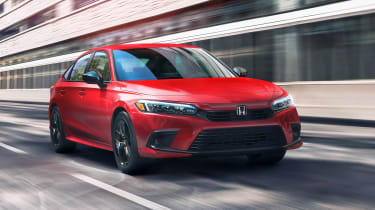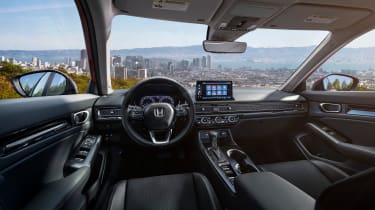Interior revolution for next-generation Civic, but European debut remains months away
This is the 11th generation Honda Civic, revealed for now in US market specification and as a saloon, but it will be heading to Europe and the UK in traditional family hatchback form later in 2021.
The next version of Honda’s long living Volkswagen Golf rival has been revealed only four years after the introduction of the Mk10 version. Compared with competitors, each iteration of the Civic has always had a shorter lifespan with smaller, evolutionary changes between the generations.
Best family cars to buy 2021
Buyers can expect plenty of change with this new model, however – in Europe it looks set to adopt hybrid power for the first time, while it’s also been subject to an intensive redesign inside and out.
We’ll need to see the Civic in hatchback form to get a true gauge of the design changes, but the firm says it has targeted a cleaner look for the Mk11, with the US market saloon version chasing a more “premium” look.
The front end adopts a more horizontal look with flatter LED headlights and more squared off nose, complemented by new front grille proportions. Now, the lower section is larger with the grille around the badge smaller. It’s a similar look to the one introduced on the new HR-V and the Jazz supermini.
New Honda Civic Type R Limited Edition 2020 review
Elsewhere, Honda points to the position of the A-pillar – it has been moved back to make the bonnet appear longer, while there’s a low beltline and a wider rear track. However, we don’t know if Honda intends to transplant a similar look onto the European hatchback.
The interior should translate over, and it marks a huge departure from what we know in the Mk10 model. A new, de-cluttered dashboard is the star of the show. It’s packaged completely differently, with a long, horizontal plane with ventilation and switchgear propping up a new floating style touchscreen infotainment system. The standard unit sizes up at seven-inches, with a nine-inch system optional. Honda says the new system comes with simpler menus and wireless Apple CarPlay and Android Auto connectivity.
It’s joined by fully digital instrumentation for the first time in the Civic. A new customisable 10.2-inch digital instrument cluster sits behind a redesigned steering wheel, but entry-level versions of the Civic use a seven-inch cluster, which retains a traditional speedometer.
Elsewhere, the brand points to the usage of higher quality interior materials, especially on touchpoints, while the seats have been redesigned too.
The new Civic makes use of an evolved version of the previous-generation’s platform. But the brand claims an eight per cent increase in torsional rigidity, for improved ride, handling and rolling refinement. This is combined with the wider rear track and a new aluminium front sub-frame, plus re-calibrated power steering.
Driver assistance features have been updated with a new version of the brand’s Sensing safety system. It no longer uses a camera and radar to read the road ahead for functions such as automatic emergency braking and identifying other cars, pedestrians and cyclists. The Sensing system now uses a single camera, with a much wider field of view than before.
Joining this hardware update, the Sensing system gains Traffic Jam Assist for low-speed semi-autonomous driving assistance, while the adaptive cruise control and lane keep assist functions behave and react more naturally to the road ahead.
Engines for the US market comprise a 2.0-litre four-cylinder petrol developing 150bhp, and a turbocharged 1.6-litre four-cylinder petrol with 180bhp, both sending drive to the front axle via a CVT automatic gearbox
These engines are unlikely to appear here, and Honda hasn’t yet released any technical information relating to the European Civic. But the company has previously confirmed that it will electrify its mainstream European line-up by 2022. Honda has already hinted that it’ll achieve this by fitting the Civic with a modified version of its innovative e:HEV hybrid powertrain, currently found in the Jazz supermini.
Tom Gardner, Senior Vice President, Honda Motor Europe, told us: “This shift to electrification will change the face of our model line-up considerably. Our two-motor [e:HEV] hybrid technology will be spread across the model range and we will bring further battery electric products to the market.”
If the Civic goes on sale with the same powertrain as the Jazz, it’ll use a 1.5-litre four-cylinder petrol engine and two electric motors; one mounted in the gearbox which drives the front wheels and one to charge the car’s lithium-ion battery.
However, in its current state of tune, the system produces 108bhp, which might not be enough for the larger Civic. So, another option could be for Honda to use a revised version of the 2.0-litre four-cylinder e:HEV system found in the current CR-V mid-size SUV.
It’s also almost certain that the brand will develop another Type R version of the next Civic, but it won’t appear until 2022 at the earliest.
Production of the next-generation Honda Civic will also move from the car’s current home at Swindon to one of Honda’s other global factories, likely in Japan. Honda is due to close the Wiltshire plant later this year, around the same time as the Civic is expected to go on sale in the UK.
Now read all the latest news on the upcoming replacement for the Honda CR-V…
Source: Read Full Article



 Best family cars to buy 2021
Best family cars to buy 2021 New Honda Civic Type R Limited Edition 2020 review
New Honda Civic Type R Limited Edition 2020 review
